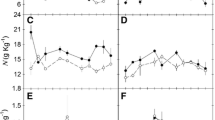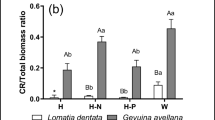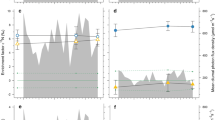Summary
The subdominant CAM species, Echinocereus viridiflorus and Mammillaria vivipara, collected from the shortgrass prairie in northeastern Colorado were pretreated and analyzed for gas exchange under cool temperatures (20/15°C) and warm temperatures (35/15°C). Well watered plants of both species under a 35/15°C thermoperiod fixed atmospheric CO2 during the night and early moring. Echinocereus viridiflorus grown and analyzed at 20/15°C fixed CO2 during the night, early morning and late afternoon but total carbon gain over a 24 h period is less than when grown and analyzed under the 35/15°C thermoperiod. Mammillaria vivipara grown and analyzed at 20/15°C assimilates CO2 at low rates during all parts of a 24 h period with the greatest CO2 fixation rates occuring from midday to late afternoon. The total carbon gain under the 20/15°C thermoperiod is less than that for this species under the 35/15°C thermoperiod. Decreasing the night temperature of plants grown under the warm conditions to 10°C or 5°C results in a depression of the night CO2 fixation in both species. E. viridiflorus from the cool growth conditions showed an enhancement of the CO2 uptake during the night, early morning and late afternoon when subjected to the cooler night temperatures (10°C and 5°C). The CO2 uptake of M. vivipara grown at 20/15°C shows an enhancement during the night and early morning while the CO2 fixation during midday and late afternoon is slightly depressed under cool night temperatures (10° and 5°C). Under the 35/15°C thermoperiod both species exhibit depressed rates of CO2 fixation during the night and early morning when water stressed. Plants of both species grown under the 20/15°C thermoperiod exhibit no net CO2 fixation following five weeks of water deprivation. Upon rewatering, E. viridiflorus begins to recover its capacity for CO2 fixation within 24 h under both the warm and cool temperature regimes. However, M. vivipara did not show recovery within 48 h following rewatering under the warm or cool temperature regime. Contrasting the patterns of gas exchange of the subdominant species, E. viridiflorus and M. vivipara, with a dominant CAM species of the shortgrass prairie, Opuntia polyacantha reveals significant differences that may well dictate the role of these species in this ecosystem. E. viridiflorus and M. vivipara have a lower capacity of carbon gain and recovery from water stress than O. polyacantha mainly due to their lack of late afternoon CO2 uptake. This study suggests that carbon gain plays an important role in limiting E. viridiflorus and M. vivipara in the shortgrass prairie ecosystem.
Similar content being viewed by others
References
Dickerson CE, Dodd JL (1976) Phenological pattern in the shortgrass prairie. Am Mid Nat 96:367–378
dinger BE, Patten DT (1972) Carbon dioxide exchange in selected species of Echinocereus (Cactaceae). Photosynthetica 6:345–353
Gerwick BC, Williams GJ (1978) Temperature and water regulation of gas exchange of Opuntia polyacantha. Oecologia (Berl) 35:149–159
Kemp PR, Williams GJ (1980) A physiological basis for niche separation between Agropyron smithii (C3) and Bouteloua gracilis (C4). Ecology 61:846–858
Lange OL, Schulze ED, Kappen L, Evenari M, Bushbom U (1975) CO2 exchange patterns under natural conditions of Caralluma negevensis, a CAM plant of the Negev desert. Photosynthetica 9:318–326
Moir WH, Trlica MJ (1976) Plant communities and vegetation pattern as affected by various treatments in shortgrass prairies of northeastern Colorado. Southwestern Nat 21:359–371
Neales TF (1973) The effect on night temperature on CO2 assimilation transpiration, and water use efficiency in Agave americana (L.). Aust J Biol Sci 26:705–714
Neales TF (1975) The gas exchange patterns of CAM plants. In: Environmental and biological control of photosynthesis. R Marcelle (ed) Junk: The Hague, pp. 290–310
Nobel PS (1976) Water relations and photosynthesis of a desert CAM plant, Agave deserti. Plant Physiol 55:576–582
Osmond CB (1976) CO2 assimilation and dissimilation in the light and dark in CAM plants. In: RH Burris and CC Black (eds), CO2 Metabolism and Plant Productivity. Univ Park Press, Baltimore. pp 217–233
Osmond CB (1978) Crassulacean acid metabolism: A curiosity in context. Ann Rev Plant Physiol 29:379–414
Osmond CB, Nott DL, Firth PM (1979) Carbon Assimilation patterns and growth of the introduced CAM plant Opuntia inermis in Eastern Australia. Oecologia (Berl) 40:331–350
Patten DT, Dinger BE (1969) Carbon dioxide exchange patterns of cacti from different environments. Ecology 50:686–688
Szarek SR, Ting IP (1974) Seasonal patterns of acid metabolism and gas exchange in Opuntia basilaris. Plant Physiol 54:76–81
Szarek SR, Ting IP (1975) Physiological responses to rainfall in Opuntia basilaris (Cactaceae). Am J Bot 62:602–609
Szarek SR, Johnson HB, Ting IP (1973) Drought adaptation in Opuntia basilaris. Significance of recycling carbon through Crassulacean acid metabolism. Plant Physiol 52:539–541
Ting IP (1976) Crassulacean acid metabolism in natural ecosystems in relation to annual CO2 uptake patterns and water utilization. In: RH Burris and CC Black (eds) CO2 Metabolism and Plant Productivity. Univ Park Press, Baltimore. pp 251–268
Throughton JH, Wells PV, Mooney HA (1974) Photosynthetic mechanisms in ancient C4 and CAM species. Carnegie Inst Year Book 73:812–816
Williams GJ, III (1974) Photosynthetic adaptation to temperature in C3 and C4 grasses. A possible ecoligical role in the shortgrass prairie. Plant Physiol 54:709–711
Williams GJ, III, Kemp PR (1976) Temperature relations of photosynthetic response in populations of Verbascum thapsus L. Oecologia (Berl) 25:47–54
Williams GJ, III Markley JL (1973) The photosynthetic pathway of Noth American shortgrass prairie species and some ecological implications. Photosynthetica 7:262–270
Author information
Authors and Affiliations
Rights and permissions
About this article
Cite this article
Green, J.M., Williams, G.J. The subdominant status of Echinocereus viridiflorus and Mammillaria vivipara in the shortgrass prairie: The role of temperature and water effects on gas exchange. Oecologia 52, 43–48 (1982). https://doi.org/10.1007/BF00349010
Received:
Issue Date:
DOI: https://doi.org/10.1007/BF00349010




